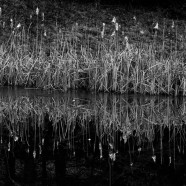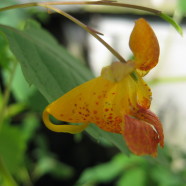Cattails: Winter Warmth
Cattails in a winter marsh, with a skim of ice on the water. This chilly picture seems to be the very essence of cold. But actually this is an image of potential warmth. You’ve seen cattail seed heads, I’m sure, when they’re just ripe–they look like a brown velvet hot dog impaled on a stick. Just one of those spikes can hold an unbelievable number of seeds–somewhere in the vicinity of a quarter of a million seeds on each stalk. Each individual seed is a tiny dot, almost invisible, attached to a little cluster of fluff, which acts as a parachute so the seeds can...
Read MoreJewelweed: Poison Ivy Cure?
Can jewelweed cure poison ivy? It’s been used for centuries as a poison ivy remedy, but results differ depending on who’s using it.
Read MoreJamestown: Faces from the Past
Jamestown, Virginia. It’s not an actual town, it’s a historic site, of course. No one lives there but ghosts. Actually there are two Jamestowns. There’s a National Park at the actual location of the first settlement in North America, and it’s an active archeological site—very educational, but not much action. And then there’s the much more commercially successful Living History Museum—the sort of place where the staff wear doublet and hose and pretend to churn butter and shoot off cannons and such. And I’m a sucker for living history. I’ve always wanted to do that—dress up in a long skirt,...
Read MoreRed Osier Dogwood: Winter Fire
This time of year, all the color seems to have drained from the world. No flowers yet, no butterflies. Even the birds are hiding till the warm weather comes. In the early spring drabness, this shrub stands out like flame against the dried brown grasses. Red Osier Dogwood–one of many species of dogwoods, with juicy berries much beloved by fall birds. The berries are long gone, but the twigs still glow like embers. It’s a native plant, a cold-weather-lover. It grows all over the US, but can even tough it out way up north in Alaska and the Yukon, where it does its best to warm the...
Read MoreHoney Locust: Something Missing
Ever see these weird wiggly worm-like seed pods lying around in a parking lot? They come from a tree, Honey Locust, Gleditsia triacanthos. The seed pods are a little sweet to taste, that’s where the honey part of the name comes from. They’re occasionally nibbled by deer and squirrels, and were even used as a sugar substitute long ago. The best thing about them, though, is that when you shake the dried pods, they have this great rattly maraca sound. Honey locust is the classic parking lot tree—it flourishes in this odd environment of cement and blacktop because it’s a particularly...
Read MoreCommon Plantain: Wayfarers All
Cruising down the Massachusetts Turnpike on a nice fall day. I’ve travelled this way so often I can recite the stops on the toll card from memory. The New England town names have a pleasing sort of rhythm to them: Framingham, Natick, Ludlow, Palmer, Weston, Newton… Eventually I stop, as all travellers do, at one of the rest areas. Impossible to tell them apart, they all look alike. Not very restful places, really. Not much here for an enterprising botanist. Lots of green, all of it mowed close as a crew cut. Weed whackers have whacked every weed into submission. The shrubs are all planted at...
Read More








Recent Comments